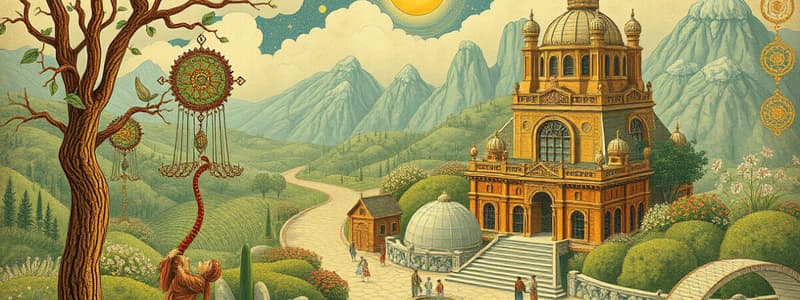Podcast
Questions and Answers
What is the definition of resources?
What is the definition of resources?
- Elements that have no utility
- Man-made items for consumption
- Natural features of the earth
- Substances useful to people (correct)
What best describes renewable resources?
What best describes renewable resources?
- Man-made resources
- Always available and never depleted
- Produced in nature more slowly than consumed by humans
- Produced in nature more rapidly than consumed by humans (correct)
Nonrenewable resources are defined as:
Nonrenewable resources are defined as:
- Produced in nature more slowly than consumed by humans (correct)
- Produced in nature more rapidly than consumed by humans
- Sustainable resources
- Resources that can be replenished easily
What is sustainability?
What is sustainability?
Define biotic.
Define biotic.
Define abiotic.
Define abiotic.
What are the 3 pillars of sustainability?
What are the 3 pillars of sustainability?
Explain the Environmental Pillar.
Explain the Environmental Pillar.
What is conservation?
What is conservation?
Provide examples of renewable and nonrenewable resources.
Provide examples of renewable and nonrenewable resources.
What is preservation?
What is preservation?
What does the Economic Pillar involve?
What does the Economic Pillar involve?
What are the 3 stable things humans rely on?
What are the 3 stable things humans rely on?
Define erosion.
Define erosion.
What is depletion of nutrients?
What is depletion of nutrients?
What is cultural ecology?
What is cultural ecology?
What is environmental determinism?
What is environmental determinism?
Define possibilism.
Define possibilism.
What sustainable ecosystem practices were used in the Netherlands?
What sustainable ecosystem practices were used in the Netherlands?
What is a polder?
What is a polder?
What are dikes?
What are dikes?
Name examples of polders and dikes.
Name examples of polders and dikes.
What are 3 characteristics of a formal region?
What are 3 characteristics of a formal region?
What are 3 characteristics of a functional region?
What are 3 characteristics of a functional region?
What are 3 characteristics of a vernacular region?
What are 3 characteristics of a vernacular region?
Define culture.
Define culture.
Flashcards are hidden until you start studying
Study Notes
Resources and Sustainability
- Resources are substances that are useful to people, including both renewable and nonrenewable categories.
- Renewable resources regenerate quickly in nature, allowing for sustainable consumption by humans.
- Nonrenewable resources, like fossil fuels, are consumed faster than their natural replenishment rate, leading to depletion concerns.
- Sustainability focuses on using both renewable and nonrenewable resources in a way that ensures their availability for future generations.
Biotic and Abiotic Systems
- A biotic system consists of living organisms that interact within an ecosystem.
- An abiotic system is made up of nonliving or inorganic components, such as soil, water, and air.
Pillars of Sustainability
- The three pillars of sustainability are Environmental, Social, and Economic, which must be balanced for sustainable practices.
- Environmental sustainability involves conservation and preservation of natural resources to minimize human impact.
- The Economic pillar revolves around the availability and management of natural resources to satisfy supply and demand.
- The Social pillar addresses the basic human needs for shelter, food, and clothing, ensuring resource allocation meets these needs.
Climate, Weather, and Physical Systems
- Climate encompasses long-term atmospheric conditions, while weather refers to short-term atmospheric events.
- Physical systems relevant to the Earth include the atmosphere, climate, hydrosphere, and lithosphere, each interacting with living organisms.
Ecosystems and Biodiversity
- The biosphere is the fourth natural system where all living organisms exist, interacting with abiotic systems.
- Ecosystems are composed of living organisms and the abiotic factors they interact with, highlighting the interdependence between life and nonliving elements.
Human Impact and Resource Management
- Erosion refers to the removal of soil by natural forces, impacting land fertility.
- Nutrient depletion occurs when plants extract nutrients faster than they can replenish, affecting agricultural productivity.
- Cultural ecology examines the relationship between human societies and their environments.
Environmental Theories
- Environmental determinism suggests that physical environments shape societal development, while possibilism argues that humans can adapt and modify their environments to overcome limitations.
Sustainable Practices in the Netherlands
- The Netherlands employs polder systems, created by draining water from areas, and dikes that act as barriers to control flooding, showcasing innovative sustainable practices.
Regional Characteristics
- Formal regions are defined by common characteristics such as language, economic activities, and environmental properties.
- Functional regions have a central node, linked through communication and transportation networks.
- Vernacular regions emerge from cultural identity and personal perceptions of an area, illustrating subjective interpretations of space.
Cultural Context
- Culture is an ensemble of beliefs, material traits, and social forms that characterize a group, influencing perceptions and environments.
Studying That Suits You
Use AI to generate personalized quizzes and flashcards to suit your learning preferences.




